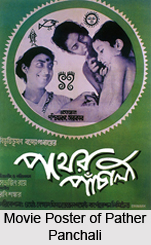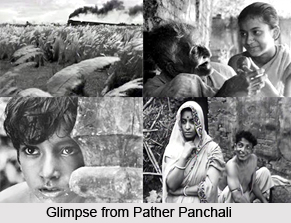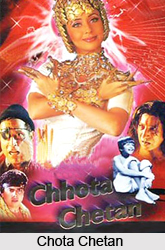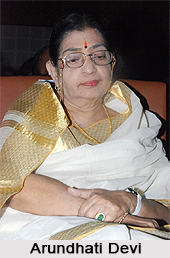 One of the early reviews that Satyajit Ray`s Pather Panchali (1955) received was--- "A beautiful picture, completely fresh and personal. (Ray`s camera) reaches forward into life, exploring and exposing, with reverence and wonder." truly enough Pather Panchali is till date considered one of the path breaking movies in the history of Bengali cinema. The film was based on the Bengali novel Bibhutibhushan Bandopadhyay by the same name.
One of the early reviews that Satyajit Ray`s Pather Panchali (1955) received was--- "A beautiful picture, completely fresh and personal. (Ray`s camera) reaches forward into life, exploring and exposing, with reverence and wonder." truly enough Pather Panchali is till date considered one of the path breaking movies in the history of Bengali cinema. The film was based on the Bengali novel Bibhutibhushan Bandopadhyay by the same name.
Pather Panchali is set in the rural Bengal of 1920s. The film is based on a family that lives in a distant village. The head of the family earns his livelihood through priesthood. He has a daughter, Durga (Uma Dasgupta) and a son, Apu (Subir Banerjee). Other than them he also looks after his wife Sarbojaya (Karuna Banerjee) and an aged cousin, Indir Thakrun (Chunibala Devi). The family struggles each day to make both ends meet as Harihar`s (Kanu Banerjee) income is meager. But Harihar is a sort of man who can be easily exploited and his decency prevents him from asking for his own dues from his employers. As a father he dotes on Durga and Apu.
 Pather Panchali beautifully depicts the strong bonding that Durga and Apu share. They tease each other, love each other and share their secrets. They are like real life children. They run after the candy man, watch bioscope shown by a travelling vendor, running across the field of Kash flowers to catch a glimpse of the train and watch drama by a traveling acting troupe. Another beautiful relation is shown between the kids, especially Durga and Indir Thakrun. However Sarbojaya and Indir Thakuran does not get along well as Sarbojaya dislikes taking responsibility of another ailing member.
Pather Panchali beautifully depicts the strong bonding that Durga and Apu share. They tease each other, love each other and share their secrets. They are like real life children. They run after the candy man, watch bioscope shown by a travelling vendor, running across the field of Kash flowers to catch a glimpse of the train and watch drama by a traveling acting troupe. Another beautiful relation is shown between the kids, especially Durga and Indir Thakrun. However Sarbojaya and Indir Thakuran does not get along well as Sarbojaya dislikes taking responsibility of another ailing member.
As the film proceeds the family is seen struggling for money and Harihar goes away to the city to earn more. With passing time less and less is heard from him by the family. In the meantime monsoon arrives and Durga gets herself drenched in rain. The already suffering family faces tragedy as Durga dies of fever on a stormy night. As the film nears its end the audience sees Apu brushing his teeth, combing his hair and doing things, which till now involved his sister and mother. His mother is surprised completely. Harihar returns and shows to his wife what he has brought from the city. As he shows the saree which he had brought for Durga his wife breaks down but her voice is lost in the sound of the `tarshahnai.` Harihar breaks down too.
Pather Panchali ends with the family moving away from the village. As the film ends the focus slowly shifts to Apu. The narrative was for so long related from the perspective of Sarbojaya and Durga. In these final moments Apu is treated by the director as an individual. The ending of Pather Panchali also builds the ground for the 2 sequels to these films: Aporajito and Apur Sansaar.
As far as Pathher Panchali is concerned there was never a complete script for the film. It was based on Satyajit Ray`s sketches and notes. The actors in Pathher Panchali played their parts to perfection. But most of them have never worked in films except for Kanu Banerjee who essayed the character of Harihar. The role of Indir Thakrun was played by Chunibala Devi, a retired stage actress living in a brothel. Uma Dasgupta for Durga was selected through an interview while Subir Banerjee was a child in Ray`s neighbourhood whom the director to chose to enact Apu. The entire film had been shot in Boral.
Lack of finance interrupted with the making of Pather Panchali so much so that the film was made a period of three years. Producers were not ready to invest in such realist films. in order to raise the required money Ray worked as a graphic designer, pawned his life insurance policy and sold his collection of LP records. Inspite of all difficulties the film was made and released. Pather Panchali received rave reviews. It created history when it attracted critical acclaim internationally.
Pather Panchali symbolised life at large. The string of incidents in the life of the Apu and Durga`s family were real. Moreover the spontaneity with which the actors enacted their parts made the film more real. Twenty years after the film was released Akira Kurosawa summed up the spirit of the film, "I can never forget the excitement in my mind after seeing it. I have had several more opportunities to see the film since then and each time I feel more overwhelmed. It is the kind of cinema that flows with the serenity and nobility of a big river... People are born, live out their lives, and then accept their deaths. Without the least effort and without any sudden jerks, Ray paints his picture, but its effect on the audience is to stir up deep passions. How does he achieve this? There is nothing irrelevant or haphazard in his cinematographic technique. In that lies the secret of its excellence."
Pather Panchali won several national and international awards. it won the following awards:
| President`s Gold and Silver Medals, New Delhi, 1955 |
| Best Human Document, Cannes 1956 |
| Diploma Of Merit, Edinburgh, 1956 |
| Vatican Award, Rome, 1956 |
| Golden Carbao, Manila, 1956 |
| Best Film and Direction, San Francisco, 1957 |
| Selznik Golden Laurel, Berlin, 1957 |
| Best Film, Vancouver, 1958 |
| Critics` Award - Best Film, Stratford, (Canada), 1958 |
| Best Foreign Film, New York, 1959 |
| Kinema Jumpo Award: Best Foreign Film, Tokyo 1966 |
| Bodil Award: Best Non-European Film of the Year, Denmark, 1966 |






